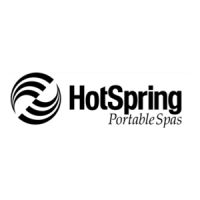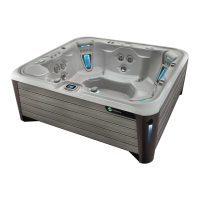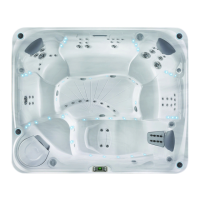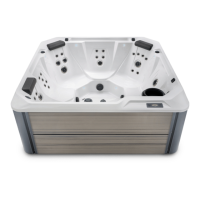Page 57
Question: When I open my spa, I smell chlorine. How do I get rid of this smell?
Answer: There are two types of chlorine in your spa. The first is the Free Available Chlorine (FAC), which is the chlorine available
to sanitize your spa. This type of chlorine does not have an odor. The second is Chloramine, which is residue from chlorine already
expended. Chloramines have a strong chlorine odor. The smell from Chloramines can be eliminated by “shocking” the water. If you
smell chlorine in the water, your spa is reminding you to add a shock treatment.
Question: Why can’t I fill my spa with soft water?
Answer: Soft water is essentially the same as regular water except that most or all of the calcium has been replaced by sodium. Soft
water may be corrosive to the heater and other components. Replacement of spa components damaged by soft water is extremely
expensive.
Question: I am trying to reduce the number of chemicals to which my family is exposed. Do I really need to use so many chemicals and
in such large amounts?
Answer: While over-exposure to any chemical can be unhealthy, many low levels of chemicals are effective and beneficial. In the
case of spa water, the chemicals recommended in the Hot Spring
®
water maintenance program are needed to protect the user from
water-borne pathogens (disease-causing microbes) and to prevent corrosion of spa components. The EverFresh
®
water care system
minimizes the use of chemicals with harsh side effects, such as halogen sanitizers.
Question: Why isn’t water chemistry damage covered by the warranty?
Answer: The chemical levels and water quality of the water in the spa are under your direct control. With proper basic care, the spa
will provide many years of hot water relaxation. If you are unsure about any chemical or its usage in the spa, contact your Authorized
Dealer, or Watkins Manufacturing Corporation.
WATER TERMINOLOGY
The following chemical terms are used in this Water Quality and Maintenance section. Understanding their meaning will help you to
better understand the water maintenance process.
Bromamines: Compounds formed when bromine combines with nitrogen from body oils, urine, perspiration, etc. Unlike chloramines,
bromamines have no pungent odor, and are effective sanitizers.
Bromine: A halogen sanitizer (in the same chemical family as chlorine). Bromine is commonly used in stick, tablet, or granular form.
See the DO’s and DON’Ts of Spa Water Maintenance for additional information.
Calcium Hardness: The amount of dissolved calcium in the spa water. This should be approximately 100-150 ppm. High levels of
calcium can cause cloudy water and scaling. Low levels can cause harm to the spa equipment.
Chloramines: Compounds formed when chlorine combines with nitrogen from body oils, urine, perspiration, etc. Chloramines can
cause eye irritation as well as having a strong odor. Unlike bromamines, chloramines are weaker, slower sanitizers.
Chlorine: An efficient sanitizing chemical for spas. Watkins Manufacturing Corporation recommend s the use of sodium dichlor-type
granulated chlorine. This type is preferred because it is totally soluble and nearly pH neutral.
Chlorine (or Bromine) Residual: The amount of chlorine or bromine remaining after chlorine or bromine demand has been satisfied.
The residual is, therefore, the amount of sanitizer which is chemically available to kill bacteria, viruses and algae.
Corrosion: The gradual wearing away of metal spa parts, usually caused by chemical action. Generally, corrosion is caused by low pH
or by water with levels of TA, CH, pH or sanitizer which are outside the recommended ranges.
DPD: The preferred reagent used in test kits to measure the Free Available Chlorine.
Halogen: Any one of these five elements: fluorine, chlorine, bromine, iodine, and astatine.
MPS: Monopersulfate is the non-chlorine oxidizer used with the FreshWater
Ag
+
®
silver ion purification system.
Nitric Acid: The formulation of nitric acid, a highly corrosive chemical, is a byproduct of the ozone generating process. Nitric acid is
produced in very small quantities and is readily dissolved in the water stream with ozone.
Oxidizer: The use of an oxidizing chemical is to prevent the buildup of contaminants, maximize sanitizer efficiency, minimize combined
chlorine and improve water clarity.
Ozone: Ozone is a powerful oxidizing agent which is produced in nature and artificially by man. Ozone forms no byproducts of
chloramines (ozone actually oxidizes chloramines) and will not alter the water’s pH.
Pathogen: A microorganism such as bacterium that cause disease.
pH: The measure of the spa water’s acidity and alkalinity. The recommended pH for the spa water is 7.4 to 7.6. Below 7.0 (considered
neutral), the spa water is too acidic and can damage the heating system. Above 7.8, the water is too alkaline and can result in cloudy
water, and scale formation on the shell and heater.
Water Quality and Maintenance

